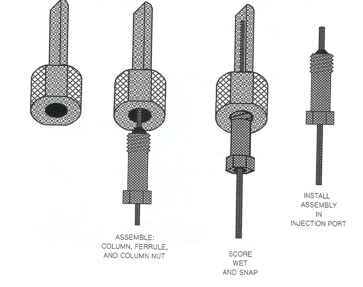Submitted by anthias on
The installation of a capillary column into a modern gas chromatograph requires precise positioning of the column into both the inlet/injection port and the detector to obtain optimum analytical performance. Individual manufacturers have different requirements for the optimum insertion length and positioning of the column which should be checked from the relevant instrument operating manual.
NB some manufacturers specify the length of column as the distance measured from the back of the column nut, some from the front edge of the ferrule.

Use of a custom tool to set the insertion distance
Some instrument manufacturers provide an optional tool (figure 1) so that the tool acts as a surrogate injector/detector, allowing the ferrule to be locked onto the column outside of the GC, with a graduated scale on the blade of the tool indicating the position to trim the column for the required insertion length. After assembly and trimming, the column nut is removed from the tool, and then inserted into the instrument. As the ferrule has already been locked onto the column at the correct length, the column will not slide through the ferrule/nut during insertion, making this step of installation much easier.
A variation of this approach may be used if a dedicated tool is not available, but only if the injection port liner does not contain any packing or obstructions (frits, wool packing etc). In this approach, the column nut and ferrule is assembled onto the column as outlined in (Part I), but an excessive length of column is deliberately fed into the fitting after inserting the column nut into the inlet/detector. The ferrule is then locked in place. The column nut is then unscrewed and the nut/ferrule/column assembly removed from the injector/detector, with the ferrule now locked onto the column, preventing any movement of the column. The length of column is trimmed to the correct insertion distance before re-inserting back into the instrument for use.
Note:
An approach often used is to mark the correct insertion distance on the capillary column using typing correction fluid. The disadvantage of this approach is that as the fluid dries in the oven, fine white particles may flake off and contaminate the instrument. This is could be a serious problem if used on the transfer line of a GC-MS for instance where the particles could be drawn into the ion source. For this reason we would not recommend the use of correction fluid for the installation of capillary columns.
To learn more about GC & GC-MS troubleshooting, attend Day 2 of our Complete GC & GC-MS course and Module 4 of our Virtual Classroom Complete GC & GC-MS course.
Don't forget that you can also subscribe to our newsletters and receive useful tips straight to your inbox!
